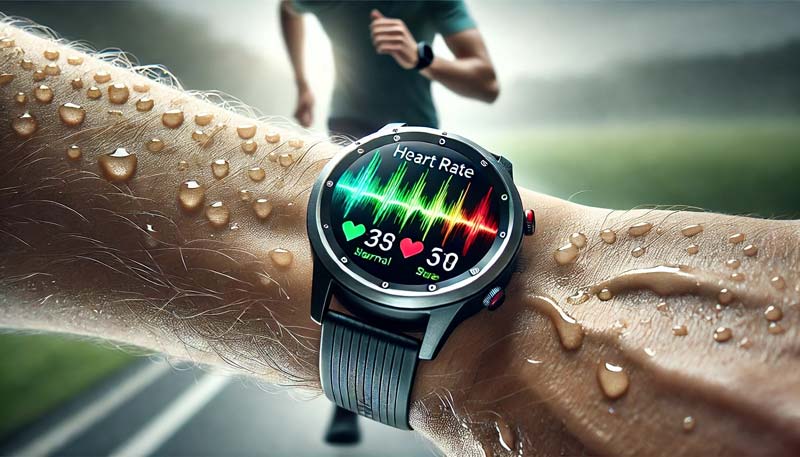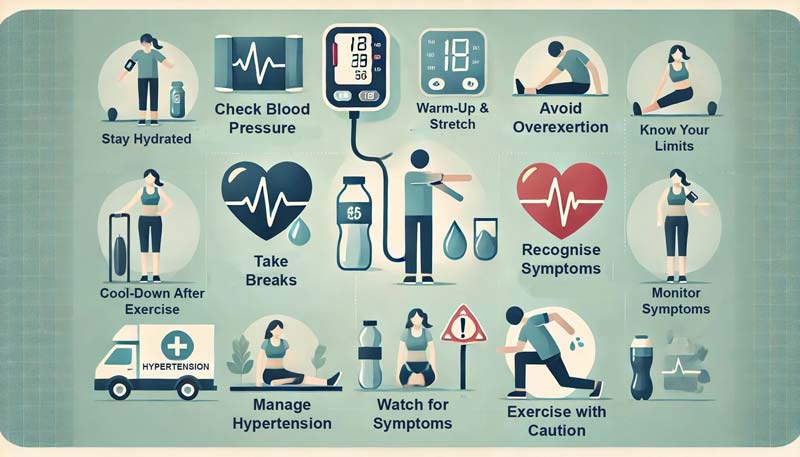By BeSund Editorial Team 11/07/2023 Modified Date: 19/09/2024
High Blood Pressure
Examine the effects of physical activity on blood pressure
High Blood Pressure and Heart Health - Hypertension

Understanding High Blood Pressure
High blood pressure and heart health are closely intertwined, affecting millions worldwide. Hypertension, the medical term for high blood pressure, is a condition where the force of blood against artery walls is consistently too high. This persistent elevation can lead to significant cardiovascular complications if left unmanaged.
Understanding high blood pressure is crucial for maintaining health and preventing severe cardiovascular issues. The condition often develops silently over time, earning its reputation as the “silent killer”. Many individuals with hypertension may not experience noticeable symptoms, making regular blood pressure checks essential for early detection and management.
Blood pressure is measured using systolic pressure (the force when the heart beats) and diastolic pressure (the force when the heart rests between beats). A regular blood pressure reading is typically below 120/80 mmHg. Readings consistently at or above 140/90 mmHg indicate hypertension. In comparison, those between 120-139/80-89 mmHg suggest prehypertension, a warning sign of potential future issues.
Risk Factors and Causes of High Blood Pressure and Heart Health
Several factors contribute to high blood pressure and heart health issues. Some are modifiable, offering opportunities for prevention and management, while others are beyond individual control.
Modifiable risk factors include:
- Poor dietary habits: High salt intake, excessive alcohol consumption, and diets low in fruits and vegetables can increase blood pressure.
- Physical inactivity: Sedentary lifestyles contribute to hypertension risk and poor heart health.
- Obesity: Excess body weight strains the heart and blood vessels.
- Smoking: Tobacco use damages blood vessels and accelerates the hardening of arteries.
Non-modifiable risk factors include:
- Age: The risk of high blood pressure increases as we get older.
- Family history: Genetic predisposition can play a role in hypertension development.
- Chronic conditions: Diseases like diabetes and kidney problems can increase hypertension risk.
Environmental factors, notably air pollution, have also been identified as significant contributors to hypertension risk and heart health issues.
The Global Burden of High Blood Pressure and Heart Health: Trends and Statistics
The World Health Organization (WHO) mortality database offers crucial insights into the global impact of high blood pressure. This resource tracks medically-certified deaths worldwide, focusing on hypertensive heart disease. Hypertensive heart disease encompasses various cardiovascular issues caused by chronic high blood pressure. These include changes in the heart’s structure and function, which can lead to heart failure and other complications. The interactive visualisation above highlights a significant increase in high blood pressure-related deaths from 1950 to 2020. In 1950, global deaths stood at 7.6 million, with 286,152 attributed to high blood pressure. By 2020, total deaths had risen to 31.7 million. High blood pressure-related deaths increased to 701,704 in the same year. This represents a 145% high blood pressure mortality increase over seven decades. Gender-specific trends in high blood pressure mortality have shifted over time. In 1950, female deaths (151,200) slightly outnumbered male deaths (134,952). However, by 2020, this pattern had reversed. Male deaths from high blood pressure (302,092) exceeded female deaths (399,612). This shift suggests changing risk factors across genders over time. The data shows a steady increase in both total deaths and high blood pressure-related deaths until 2019. In 2019, total deaths reached 38.2 million, with 796,982 attributed to high blood pressure. The figures for 2020 show a slight decline, possibly due to changes in reporting during the global pandemic. Total deaths decreased to 31.7 million, with 701,704 high blood pressure-related deaths. It’s important to note that data for 2021 and 2022 show a significant decline in recorded deaths. This is due to incomplete reporting, a limitation of the WHO database. The WHO continues to update these figures as new data becomes available. Therefore, the apparent drop in recent years doesn’t necessarily reflect a decrease in mortality rates. The global burden of high blood pressure and its impact on heart health is further illustrated by recent WHO statistics. An estimated 1.28 billion adults aged 30-79 years worldwide have hypertension, with two-thirds living in low- and middle-income countries. Alarmingly, only 21% of adults with hypertension have their condition under control. This underscores the critical need for improved awareness, diagnosis, and management strategies for high blood pressure and heart health globally. The prevalence of high blood pressure varies across regions, with the WHO African Region showing the highest rate at 27%. This disparity highlights the need for targeted interventions in different geographical areas to address high blood pressure and improve heart health. 
Exercise: The Natural Remedy for High Blood Pressure and Heart Health
While high blood pressure and heart health issues pose significant challenges, exercise is powerful in combating these conditions. Regular physical activity is crucial in managing blood pressure and improving cardiovascular health. Exercise helps lower high blood pressure by strengthening the heart, reducing arterial stiffness, and improving blood flow. Moreover, it contributes to weight management, stress reduction, and enhanced insulin sensitivity, all of which positively impact blood pressure and heart health. Studies have shown that aerobic exercises (like brisk walking, swimming, or cycling) and resistance training can significantly reduce blood pressure levels. Even moderate-intensity exercise, performed regularly, can lead to substantial improvements in cardiovascular health. The benefits of exercise extend beyond just lowering blood pressure. Regular physical activity also improves overall heart function, reduces the risk of heart disease, and enhances quality of life. Exercise is a cornerstone in preventing and managing high blood pressure and heart health issues.
The Impact of High Blood Pressure and Heart Health on Physical Performance
Hypertension significantly influences an individual’s physical performance. The effects extend beyond resting states, manifesting during various forms of physical activity. Understanding these impacts is crucial for those managing this condition and aiming to maintain an active lifestyle. Individuals with elevated blood pressure often experience altered cardiovascular responses during exercise. These changes can affect overall performance, endurance, and recovery. Moreover, the relationship between physical activity and blood pressure control becomes critical in managing the condition effectively.
Exercise Capacity and Endurance: Challenges of High Blood Pressure and Heart Health
Hypertension can substantially impact exercise capacity and endurance. Individuals with high blood pressure and compromised heart health often experience impaired exercise tolerance compared to those with normal blood pressure. This impairment manifests as a reduced ability to perform physical activities at the same intensity as normotensive individuals. The mechanisms behind this reduced exercise capacity are multifaceted. Altered hemodynamics and vascular function play significant roles. During physical exertion, hypertensive individuals may experience exaggerated increases in blood pressure, leading to increased cardiovascular strain. These physiological changes can result in an earlier onset of fatigue and decreased overall endurance. Consequently, individuals with elevated blood pressure may find it challenging to sustain prolonged physical activity or perform high-intensity exercises.
Cardiovascular Strain During Physical Activity
The cardiovascular system of individuals with hypertension experiences heightened strain during physical activities. This increased strain is particularly evident in the blood pressure response to exercise. In healthy individuals, systolic blood pressure typically rises during dynamic physical activities like running. However, this elevation is more pronounced in people with high blood pressure and heart health concerns. The diastolic pressure may remain stable or increase slightly, primarily due to reduced vasodilating capacity. This exaggerated blood pressure response can increase the heart’s workload during exercise. As a result, individuals with hypertension may experience more significant cardiovascular stress during physical activities, potentially limiting their performance and increasing fatigue.
Managing High Blood Pressure and Heart Health for Safe Exercise
Proper management of hypertension is crucial for safe and effective exercise participation. Uncontrolled high blood pressure can lead to exaggerated responses during physical activity, potentially increasing the risk of adverse events. Regular physical activity helps lower resting blood pressure and decreases the response during both physical exertion and mental stress. This dual benefit emphasises the importance of exercise in managing hypertension. However, it’s essential to approach exercise with caution. Historically, certain types of exercise, such as isometric resistance training, were discouraged for people with high blood pressure and heart health concerns due to worries about extreme hypertensive responses. Current research suggests these concerns have been overstated. With proper management and monitoring, various forms of exercise can be safe and beneficial for individuals with hypertension. The key lies in gradual progression, appropriate intensity, and regular blood pressure monitoring. This approach allows individuals to work towards improved cardiovascular fitness while managing their condition effectively. 
Exercise as a Management Tool for Hypertension
Regular physical activity emerges as a powerful ally in managing high blood pressure and heart health. This non-pharmacological approach offers a range of benefits beyond mere blood pressure control, contributing significantly to overall cardiovascular wellness. Aerobic Exercise: A Cornerstone of Hypertension Management
- Substantial blood pressure reductions: Studies show aerobic exercise can lower systolic blood pressure by 5-15 mmHg in hypertensive individuals.
- Broad applicability: Benefits observed across various groups, including middle-aged hypertensives and those with uncontrolled hypertension.
- Long-term impact: Even modest decreases in blood pressure can significantly reduce cardiovascular mortality risk.
Resistance Training: An Unexpected Ally
- Complementary benefits: Resistance exercises offer a well-rounded approach to blood pressure management.
- Measurable results: Meta-analyses report net decreases of 3.9 mmHg in both systolic and diastolic blood pressure.
- Versatility: Suitable for various fitness levels, enhancing overall physical health alongside blood pressure control.
High-Intensity Interval Training (HIIT): Efficiency Meets Effectiveness HIIT has garnered attention for its potential in improving cardiovascular health and managing high blood pressure. This time-efficient approach offers:
- Comparable benefits to moderate continuous exercise
- Reduced time commitment
- Potential for greater adherence due to variety and shorter sessions
Mechanisms of Action Exercise’s positive impact on high blood pressure and heart health stems from multiple physiological adaptations:
- Enhanced endothelium-dependent vasodilation
- Reduced sympathetic nervous system activity
- Improved vascular function
- Volume-depleting effects contributing to antihypertensive properties
These adaptations collectively contribute to better blood pressure control and overall cardiovascular health. Beyond Blood Pressure: Holistic Health Benefits Regular exercise in managing high blood pressure and heart health extends beyond hypertension control: ✓ Improved lipid profiles ✓ Enhanced glucose control ✓ Better weight management ✓ Reduced risk of cardiovascular events ✓ Enhanced quality of life These additional benefits highlight the multifaceted impact of exercise on overall cardiovascular health. The combination of direct blood pressure reduction and improvements in related health markers highlights the potential of physical activity as a comprehensive management tool for hypertension. Current research continues to explore optimal exercise prescriptions for individuals with high blood pressure and heart health concerns. Factors such as exercise type, intensity, duration, and frequency are being studied to refine recommendations and maximise benefits for diverse populations.
Recommended Exercises for Individuals with High Blood Pressure and Heart Health
Tailoring exercise programmes for individuals with high blood pressure and heart health concerns requires careful consideration. A well-rounded approach typically includes aerobic activities, strength training, and flexibility exercises. This combination aims to improve cardiovascular fitness while effectively managing blood pressure.
Optimal Exercise Types for Managing High Blood Pressure and Heart Health
Managing high blood pressure and heart health through exercise involves various activities. Each type of exercise contributes uniquely to overall cardiovascular wellness and blood pressure control. Individuals can create a comprehensive routine addressing multiple health aspects by incorporating various exercise modalities. Aerobic Exercises:
- Brisk walking: An accessible and low-impact option suitable for most fitness levels.
- Cycling: Either outdoors or on a stationary bike, offering joint-friendly cardiovascular benefits.
- Swimming: Provides full-body workout with minimal stress on joints.
- Jogging: For those with controlled blood pressure cleared by their healthcare professional.
Strength Training:
- Circuit training: Involves more repetitions with lighter weights, potentially more effective for blood pressure management.
- Resistance band exercises: Offers variable resistance and is suitable for home workouts.
- Bodyweight exercises: Squats, push-ups, and lunges can be adapted to various fitness levels.
Flexibility and Balance:
- Stretching: Improves overall mobility and complements other exercise forms.
- Yoga: Combines flexibility, balance, and stress reduction benefits.
- Tai Chi: Gentle movements that enhance balance and body awareness.
Isometric Resistance Training (IRT):
- Handgrip exercises: Sustained contractions at 30% of maximum voluntary contraction.
Wall squats: Lower limb IRT showing promising results in blood pressure reduction. 
FITT Recommendations for High Blood Pressure and Heart Health
The FITT principle—frequency, Intensity, Time, and Type—provides a structured approach to exercise prescription for individuals with high blood pressure and heart health concerns. These guidelines offer a framework for creating safe and effective exercise routines, allowing personalisation based on individual needs and fitness levels. Frequency:
- Aim for 3-5 days per week of aerobic exercise.
- Incorporate resistance training 2-3 non-consecutive days per week.
- Perform flexibility exercises daily, if possible.
Intensity:
- Aerobic: Moderate intensity (40-59% of VO2 or heart rate reserve).
- Resistance: 60-70% of one-repetition maximum (1-RM); progress to 80% 1-RM as tolerated.
- Flexibility: Stretch to the point of mild discomfort.
Time:
- Aerobic: 30-60 minutes per session, can be accumulated in 10-minute bouts.
- Resistance: 2-4 sets of 8-12 repetitions for each major muscle group.
- Flexibility: Hold each stretch for 10-30 seconds, repeating 2-4 times.
Type:
- Aerobic: Walking, cycling, swimming, or other rhythmic activities using large muscle groups.
- Resistance: Machine weights, free weights, resistance bands, or bodyweight exercises.
- Flexibility: Static stretching, dynamic stretching, or yoga.
Adapting these recommendations based on individual fitness levels and blood pressure status is crucial. Gradually increasing exercise intensity and duration over time helps ensure Safety and effectiveness in managing high blood pressure and heart health.
Safety Measures and Precautions for Exercising with Hypertension
Exercise can be a powerful tool for managing high blood pressure and heart health. Still, it’s crucial to approach physical activity with caution and awareness. Following proper safety measures and precautions, individuals with hypertension can maximise the benefits of exercise while minimising potential risks. Before You Start:
- Consult your healthcare professional: This is especially important for those with uncontrolled hypertension or additional cardiovascular risk factors.
- Understand your baseline: Know your typical blood pressure readings and any symptoms indicating problematic increases during exercise.
- Get a proper assessment: Consider an exercise stress test to determine safe activity levels.
Monitoring Blood Pressure: ✓ Before exercise: Check your blood pressure to ensure it’s within a safe range to begin activity. ✓ During exercise: Be aware of how your body responds to different types and intensities of exercise. ✓ After exercise: Monitor for any unusual changes in blood pressure post-activity. Key Safety Tips:
- Start slowly: with low to moderate-intensity exercises and gradually increase duration and intensity.
- Avoid the Valsalva manoeuvre: Don’t hold your breath during exertion, as it can cause sharp blood pressure increases.
- Warm-up and cool-down: Allow for gradual changes in blood pressure at the beginning and end of your workout.
- Stay hydrated: Proper fluid intake helps maintain healthy blood pressure during exercise.
- Listen to your body: Be alert to signs of exercise intolerance or excessive blood pressure elevation.
Warning Signs to Watch For:
- Severe shortness of breath
- Chest pain or discomfort
- Dizziness or feeling faint
- Irregular heartbeat: If you experience these symptoms, stop exercising immediately and seek medical attention.
Progressing Safely: → Increase duration before intensity: Aim to extend your exercise time before ramping up the difficulty. → Follow the 10% rule: Increase your activity level by no more than 10% per week. → Use the Borg Scale: Monitor your perceived exertion, especially if you’re taking beta-blockers, which may alter your heart rate response. Special Considerations:
- Resistance training: Set limits on blood pressure increases. A rise of more than 20 mmHg over baseline diastolic blood pressure or exceeding 120 mmHg during exercise warrants a review of your programme.
Genetic factors: Due to genetic differences, individual responses to exercise can vary. Your healthcare provider can help tailor your exercise plan accordingly. 
Living with High Blood Pressure and Heart Health: Fitness and Lifestyle Tips
Managing high blood pressure and heart health requires a comprehensive approach beyond exercise. Incorporating daily habits and lifestyle changes can significantly impact blood pressure control and overall cardiovascular wellness. Dietary Recommendations:
- Follow the DASH (Dietary Approaches to Stop Hypertension) diet:
- Emphasise fruits, vegetables, whole grains, and low-fat dairy products
- Limit saturated fats and sodium intake
- Aim for 4,700 mg of potassium daily through food sources
- Reduce sodium intake:
- Limit to less than 2,300 mg per day
- For some individuals, further reduction to 1,500 mg may be beneficial
Stress Management Techniques: ✓ Practice meditation or mindfulness: 10-15 minutes daily can help lower blood pressure ✓ Try deep breathing exercises: Slow, controlled breathing can have immediate calming effects ✓ Engage in yoga: Combines physical activity with stress reduction benefits ✓ Progressive muscle relaxation: Can help reduce tension and promote relaxation Sleep and Recovery:
- Aim for 7-9 hours of quality sleep per night
- Maintain a consistent sleep schedule
- Create a relaxing bedtime routine
- Limit exposure to screens before bedtime
Monitoring and Long-term Management:
- Regular blood pressure checks:
- Consider 24-hour ambulatory blood pressure monitoring for a comprehensive assessment
- Attend scheduled health check-ups
- Adhere to prescribed medications, if any
- Stay informed about new developments in cardiovascular health
Lifestyle Modifications:
- Limit alcohol consumption: No more than one drink per day for women, two for men
- Quit smoking: Seek support through cessation programs if needed
- Maintain a healthy weight: Aim for a BMI between 18.5 and 24.9
- Reduce sedentary time: Break up long periods of sitting with short activity breaks
Sustainable Fitness Strategies:
- Incorporate physical activity into daily routines:
- Take stairs instead of lifts
- Park farther away from destinations
- Garden or do household chores actively
- Set realistic, achievable fitness goals
- Find enjoyable forms of exercise to maintain motivation
- Consider joining group fitness classes or finding an exercise partner for accountability
When you integrate these lifestyle tips with regular exercise, individuals living with high blood pressure and heart health concerns can work towards improved cardiovascular wellness and overall quality of life.
Sources
- American College of Sports Medicine. ACSM’s Guidelines for Exercise Testing and Prescription. 10th ed. Philadelphia (PA): Wolters Kluwer; 2018.
- Appel LJ, Brands MW, Daniels SR, Karanja N, Elmer PJ, Sacks FM. Dietary approaches to prevent and treat hypertension: a scientific statement from the American Heart Association. Hypertension. 2006;47:296-308.
- Chobanian AV, Bakris GL, Black HR, et al. Joint National Committee on Prevention, Detection, Evaluation, and Treatment of High Blood Pressure. National Heart, Lung, and Blood Institute; National High Blood Pressure Education Program Coordinating Committee. Seventh report of the Joint National Committee on Prevention, Detection, Evaluation, and Treatment of High Blood Pressure. Hypertension. 2003;42:1206—52.
- Ciolac EG. High-intensity interval training and hypertension: maximising the benefits of exercise? Am J Cardiovasc Dis. 2012;2:102–10.
- Cornelissen VA, Fagard RH, Coeckelberghs E, Vanhees L. Impact of resistance training on blood pressure and other cardiovascular risk factors: a meta-analysis of randomised, controlled trials. Hypertension. 2011;58:950–8.
- Fagard RH, Cornelissen VA. Effect of exercise on blood pressure control in hypertensive patients. Eur J Cardiovasc Prev Rehabil. 2007;14:12-7.
- Fagard RH. Exercise characteristics and the blood pressure response to dynamic physical training. Med Sci Sports Exerc. 2001;33:S484-92.
- Gordon NF. Hypertension. In: Durstine JL, editor. ACSM’s exercise management for persons with chronic diseases and disabilities. Champaign (IL): Human Kinetics; 1997.
- Hagberg J, Park JJ, Brown M. The role of exercise training in the treatment of hypertension: an update. Sports Med. 2000;30:193-206.
- Haskell WL. Health consequences of physical activity: understanding and challenges regarding dose-response. Med Sci Sports Exerc. 1994;26:649-60.
- Head GA, McGrath BP, Nelson MR, et al. Importance of ambulatory blood pressure in hypertension management. Med J Aust. 2012;197:143–144.
- Iacovides S, Meiring RM. The effect of a ketogenic diet versus a high-carbohydrate, low-fat diet on sleep, cognition, thyroid function, and cardiovascular health independent of weight loss: Study protocol for a randomised controlled trial. Trials. 2018;19:62.
- Inder JD, Carlson DJ, Dieberg G, McFarlane JR, Hess NC, Smart NA. Isometric exercise training for blood pressure management: a systematic review and meta-analysis to optimise benefit. Hypertens Res. 2016 Feb;39(2):88-94.
- Kearney PM, Whelton M, Reynolds K, Muntner P, Whelton PK, He J. Global burden of hypertension: analysis of worldwide data. Lancet. 2005;365:217–23.
- Kelley GA, Kelley KS. Progressive resistance exercise and resting blood pressure: a meta-analysis of randomised controlled trials. Hypertension. 2000;35:838-43.
- Lim P, Macfadyen RJ, Clarkson PB, et al. Impaired exercise tolerance in hypertensive patients. Ann Intern Med. 1996;124:41—55.
- MacDougall JD, Tuxen DSDG, Moroz JR, et al. Arterial blood pressure response to heavy resistance exercise. J Appl Physiol. 1985;58:785-90.
- Morales MC, Coplan NL, Zabetakis P, et al. Hypertension: the acute and chronic response to exercise. Am Heart J. 1991;122:264.
- Nelson L, Esler MD, Jennings GL, et al. Effect of changing levels of physical activity on blood-pressure and haemodynamics in essential hypertension. Lancet. 1986;2:473-6.
- Park S, Rink LD, Wallace JP. Accumulation of physical activity leads to a greater blood pressure reduction than a single continuous session, in prehypertension. J Hypertens. 2006;24:1761-70.
- Pescatello LS, Franklin BA, Fagard R, Farquhar WB, Kelley GA, Ray CA. American College of Sports Medicine position stand. Exercise and hypertension. Med Sci Sports Exerc. 2004;36:533–53.
- Pescatello LS, Franklin BA, Fagard R, et al. American College of Sports Medicine position stand. Exercise and hypertension. Med Sci Sports Exerc. 2004;36:533-53.
- Proper KI, Singh AS, van Mechelen W, Chinapaw MJ. Sedentary behaviors and health outcomes among adults: a systematic review of prospective studies. Am J Prev Med. 2011;40:174–82.
- Sacks F.M., Svetkey L.P., Vollmer W.M., Appel L.J., Bray G.A., Harsha D., Obarzanek E., Conlin P.R., Miller E.R., III, Simons-Morton D.G., et al. DASH-Sodium Collaborative Research Group. Effects on blood pressure of reduced dietary sodium and the Dietary Approaches to Stop Hypertension (DASH) diet. DASH-Sodium Collaborative Research Group. N. Engl. J. Med. 2001;344:3–10.
- Schneider RH, Alexander CN, Staggers F, et al. A randomised controlled trial of stress reduction in African Americans treated for hypertension for over one year. Am J Hypertens. 2005;18:88-98.
- Stamler J, Rose G, Stamler R. INTERSALT study findings. Public health and medical care implications. Hypertension. 1989;14:570-7.
- Taylor KA, Wiles JD, Coleman DA, et al. Neurohumoral and ambulatory haemodynamic adaptations following isometric exercise training in unmedicated hypertensive patients. J Hypertens. 2019;37:827-836.
- The sixth report of the Joint National Committee on prevention, detection, evaluation, and treatment of high blood pressure. Arch Intern Med. 1997 Nov 24;157(21):2413-46.
- Urata H, Tanabe Y, Kiyonaga A, et al. Antihypertensive and volume-depleting effects of mild exercise on essential hypertension. Hypertension. 1987;9:245-52.
- Wallace J. Exercise in hypertension: a clinical review. Sports Med. 2003;33:1.
- Whelton PK, Carey RM, Aronow WS, Casey DE Jr, Collins KJ, Dennison Himmelfarb C, DePalma SM, Gidding S, Jamerson KA, Jones DW, MacLaughlin EJ, Muntner P, Ovbiagele B, Smith SC Jr, Spencer CC, Stafford RS, Taler SJ, Thomas RJ, Williams KA Sr, Williamson JD, Wright JT Jr. 2017 ACC/AHA/AAPA/ABC/ACPM/AGS/APhA/ASH/ASPC/NMA/PCNA Guideline for the Prevention, Detection, Evaluation, and Management of High Blood Pressure in Adults: Executive Summary: A Report of the American College of Cardiology/American Heart Association Task Force on Clinical Practice Guidelines. Hypertension. 2018 Jun;71(6):1269-1324.
- Williams B, Mancia G, Spiering W, et al. 2018 Practice Guidelines for the management of arterial hypertension of the European Society of Hypertension and the European Society of Cardiology. J Hypertens. 2018;36:2284–2309.
- World Health Organization. Hypertension – Key facts.
- World Health Organization. The WHO mortality database for Hypertensive Heart Disease.


